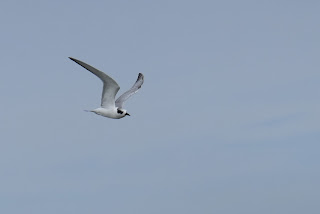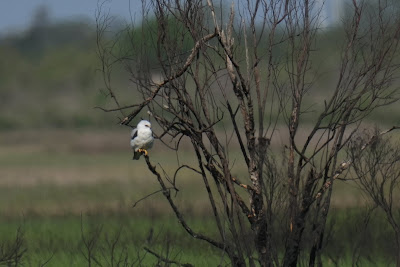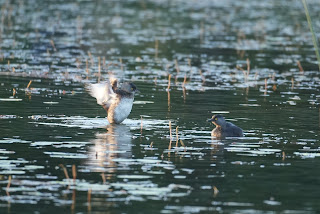Alternative Blog Post Title: Everything is Bigger in Texas - Excluding Bird Lists
Snowy Plovers in Galveston TX
Hey Y'all,
I spent the last five days in Texas with my family. If you see me wearing a cowboy hat, cowboy boots, and driving a large, diesel-powered pickup truck with modified suspension, and a giant exhaust pipe, ... just joking --- I'm still a Tree-Hugger from Ontario. Birding was big on my priority list - but not the only Priority - we also did lots of other things such as rail fanning, hiking, visiting amusement parks and lots of great restaurants.
In theory - could have had had as many 15-20 life birds. Some birds that I could have seen include:
Yellow Fronted Woodpecker
Golden cheeked warbler
Least Grebe
Neotropical Cormorant
Seaside Sparrow
Lecontes Sparrow
Snowy Plover
White Tailed Kite
Attwater Prairie Chicken
Black headed Vireo
Black crested titmouse
Gull billed Tern
Least Tern
Huttons Vireo
Zone tailed Hawk
White tailed Hawk
Olive Sparrow
My trip to Texas involved small sub-trips--- We landed in Houston, went to Austin, San Marcos, San Antionio, then back to Houston (clear lake area - near Nasa Space Center). From Clear Lake, we were between Houston and Galveston. Galveston is a large barrier island on the Gulf of Mexico.
Spring Lake Area - San Marcos
This was my first birding effort on this trip - and immediately as I got out of my car, I heard a yellow throated vireo singing. Northern Parula, Eastern Phoebe, Pied billed Grebe, Cormorants, White eyed Vireos were all easily seen within 100m walk from my car. Another trailhead in this area should have easily given me yellow-fronted woodpeckers, black crested titmouse and even Golden cheeked Warblers - but I had only heard the call of black crested titmouse.
"The Caves" in San-Antonio
The birding and butterfly watching was surprisingly good here even thought its really a tourist attraction. There were tonnes of birds. Sadly, I was in the midst of a cave tour and I didn't want to make a scene birdwatching as our guide was talking about the local geology. I might have had Olive Sparrows there -- but I can't be certain. I did see Black crested Titmouse though which was really nice. A few nice butterflies were around as well. I had found a tree near the parking lot crawling with butterflies (it was similar to button-bush).
Black crested Titmouse!
Galveston Island State Park, East Beach, Bolivar Flats
I was really hoping to see Snowy Plovers at this location and sure enough, I had found a small group of about 5-10. Lots of shorebirds were present. American Avocets, various sandpipers, Rudy Turnstones, Skimmers, Gulls, etc. Turns, Eastern Meadowlarks, Savanah Sparrows, Horned Larks, Grackles etc were seen. I was hoping to see Least Terns - but I might have been a week early. Also, I did not really have time to see the bolivar flats even thought I visited the area.
Snowy Plover - A long sought lifer.
My son --- would rather be rail-fanning.
White Tailed Kite. Lifer!
Neotropic Cormorant (LIFER!) - I have missed this many, many times in Windsor/Essex. Not as common as I was expecting!
Clay Family Eastern Glades
This stunning park was a pleasant surprise. Ebird hinted that Least Grebes were present --- and sure enough, a small family? of three were present.
Butterflies - I was able to see Southern Dogface, Henry's Elfin - as well as many other species that I had seen previously such as Funeral Duskywing, Dainty Sulpher, Varigated and Gulf Fritillary, common buckey, red admiral, monarch, Giant Swallowtail, Eastern Tiger, Pipevine Swallowtail. I did see a reakirts blue but no other hairstreak like butterflies. (too early)
Southern Dogface - Lifer!
Henry's Elfin - A butterfly Lifer!
Plants - I didn't make much efforts to see southern species --- but I did make some basic observations of some plants that were obvious to a casual observer. For example, many roadsides are covered in a blue flower --- and it was neat to followup on what that plant was - a local lupine called "Bluebonnet Lupine". Indian Paintbrush ? had a redish colour as well. I noted a yellow-flowering thistle plant, as well as many colourful daisy like species.
Astronomy - I was curious if I would be able to see one particular astronomical phenomena --- Omega Centauri --- it is one of the largest dense star clusters in our solar system. Dense star clusters are thought to be remnants of smaller elliptical galaxies that were absorbed by our milky way galaxy. Its really best seen from the southern hemisphere, but can be seen low on the southern horizon from Texas. I made huge efforts to see this--- The light pollution is horrible. Every business, strip mall , hotel and car dealership is lit up like daylight at night. You are hard pressed to see a single star within an hours drive of downtown Houston.
Omega Centauri [link]
So all in all - it was a great trip. I have never been to Texas, and I must say its a pretty interesting place. There is a huge oil-based economy and there seems to be great wealth there. The vast swaths of land are incredible. There is great development, yet, large swatchs of natural areas. There seems to be little effort to recycle glass, plastic, metal --- only garbages --- which is strange to me.
I was hoping to cross paths with more like 15-20 birds, but --- I found 5 ... A little less than I would have liked. Some birds might have been easier if I was there two weeks earlier, and others if I was there two weeks later. Its all good. Someone told me once that you need to save some birds for retirement.
Good Birding!
Dwayne
Last 15 Life Birds:
Western Screech Owl 453 (AZ)
Scaled Quail 454 (AZ)
Graces Warbler 455 (AZ)
Painted Redstart 456 (AZ)
Yellow Eyed Junco 457 (AZ)
Blue throated Hummingbird 458 (AZ)
Elegant Trogon 459 (AZ)
King Rail 460
Red Phalarope 461
Scissor tailed Flycatcher 462
Hoary Redpoll 463
Cave Swallow 464
Harris' Sparrow 465
Black crested Titmouse (TX) 466
Snowy Plover (TX) 467
Neotropical Cormorant (TX) 468
White tailed Kite (TX) 469
Least Grebe (TX) 470










































